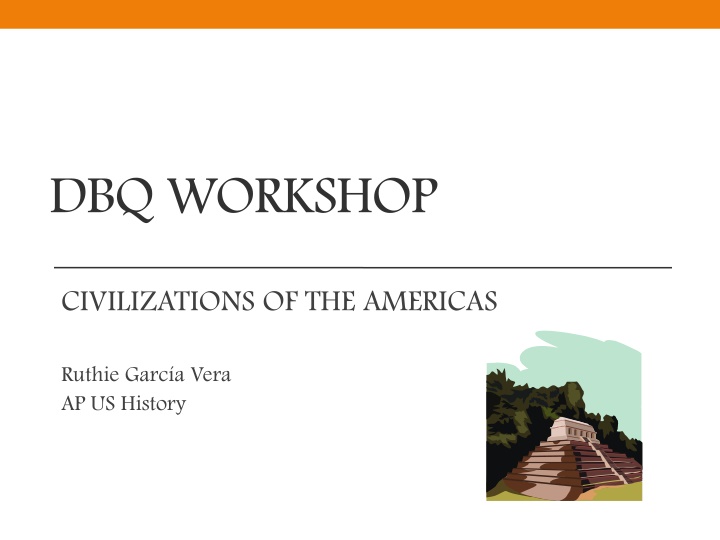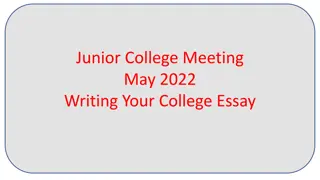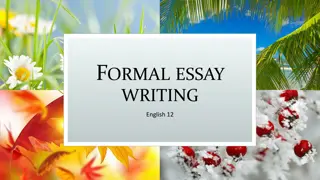History Essay Writing Tips and Questioning Levels
Learn the levels of questioning for essay writing: Recall, Analysis, and Synthesis. Discover essential tips for writing history essays, including thesis statements, using evidence, and avoiding common mistakes. Understand different question modes and how to structure your arguments effectively.
Download Presentation

Please find below an Image/Link to download the presentation.
The content on the website is provided AS IS for your information and personal use only. It may not be sold, licensed, or shared on other websites without obtaining consent from the author.If you encounter any issues during the download, it is possible that the publisher has removed the file from their server.
You are allowed to download the files provided on this website for personal or commercial use, subject to the condition that they are used lawfully. All files are the property of their respective owners.
The content on the website is provided AS IS for your information and personal use only. It may not be sold, licensed, or shared on other websites without obtaining consent from the author.
E N D
Presentation Transcript
DBQ WORKSHOP CIVILIZATIONS OF THE AMERICAS Ruthie Garc a Vera AP US History
Answering an Essay Question Answering an Essay Question There are 3 Levels of Questioning There are 3 Levels of Questioning Level 1: Recall Level 1: Recall The answer is in the text; explicit, fact. (fully and clearly expressed; leaving nothing implied) How did Cinderella get to the ball? What were her slippers made out of?
Level II : Analysis Inference Level II : Analysis Inference ( (The act or process of deriving logical conclusions from premises known or assumed to be true) Implicit or what is implied; analysis, ask how and why, require analysis of the text, reading between the lines, hidden meaning, (understood though not directly expressed). Why does Cinderella stepmother care whether she went to the ball? Why did everything turn back the way it was except the slipper? Why don t the stepsisters like Cinderella?
Level III : Synthesis Level III : Synthesis Go beyond the text and inquire into the value, importance and application of the information presented. Does a women s salvation always lie with a man? What does it mean to live happily ever after? Does good always overcome evil?
Writing a History Essay Writing a History Essay 1. Have a thesis statement 2. Get to the point 3. Use factual evidence 4. Take contrary evidence into account 5. End the essay simply & cleanly 6. Do NOT use personal pronouns 7. Do NOT misspell or use poor grammar 8. Do NOT ask rhetorical questions
Question Modes in a History Essay Question Modes in a History Essay Analyze Define Assess/evaluate Enumerate Compare/Contrast Illustrate Criticize Interpret Describe Justify Discuss Prove Explain Rank Identify Trace
The Thesis Statement The Thesis Statement MAGIC FORMULA: X. However, A, B, and C. Therefore, Y. X. However, A, B, and C. Therefore, Y. X= the strongest point against against your argument A,B, & C= the 3 strongest points for for your argument Y= the position you will be taking (your stand on the prompt Assess the validity of the following statement: Teaching is the most important profession in the world and Teaching is the most important profession in the world and everyone should consider it as a possible career choice. everyone should consider it as a possible career choice.
Pros Cons Physically demanding Emotionally satisfying Low pay Make a difference in the world Long work hours Summers off Not much respect in our society Work during the summer for more pay Requires certification Have to do additional work coach, etc. Not much competition in job market Work usually comes home with you Only need a bachelors degree
Sample Thesis X. However, A, B, and C. Therefore, Y. X. However, A, B, and C. Therefore, Y. Teaching is an emotionally satisfying profession. However, teachers rank consistently at the bottom of the pay scale, often work at home without just compensation, and receive a lack of respect in our society. Therefore, teaching is clearly not the most important profession and would be an unwise career choice.
X X. However, . However, A A, , B B, and , and C C. Therefore, . Therefore, Y Y. . Teaching is an emotionally satisfying profession. Teaching is an emotionally satisfying profession. However, However, teachers rank consistently at the bottom teachers rank consistently at the bottom of the pay scale of the pay scale, , often work at home without just often work at home without just compensation compensation, , and and receive a lack of respect in our receive a lack of respect in our society. society. Therefore Therefore, teaching is clearly not the most , teaching is clearly not the most important profession and would be an unwise important profession and would be an unwise career choice. career choice.
Grouping/Categorizing the Documents & Outside Information Categorizing information involves creating simple or sophisticated groupings of information. Often, the question posed will determine the types of categories used: Cultural Cultural: the technology, arts and institutions of a given group of people at a given time. Economic Economic: the ways that people meet their basic needs; the production, distribution and consumption of goods and services; includes such issues as domestic and international trade, monetary policies and taxes.
Geographic: Geographic: the environment in which people live and interact. Ideological: Ideological: relating to the ideas, the manner or the content of the thinking characteristics of an individual, group or culture. Intellectual: Intellectual: the people s philosophy, values, beliefs and attitudes. Legal: Legal: pertaining to the law; conforming to or permitted by established laws or rules. Political: Political: gaining, seeking and organizing power; events related to the functions of government: making laws, enforcing laws and interpreting laws.
Religious Religious: : religion or beliefs, whether organized or traditional and the religious institutions of the culture. (It is sometimes viewed as a subcategory of culture, but can be separated to add emphasis) Social: Social: people in groups, their living together and relations with one another; includes such issues as gender, ecvonomic status and ethnicity. Constitutional Constitutional: in accordance with or authorized by the Constitution of the United States or the constitution of individual states or countries.
HOW ADVANCED WERE THE MAYAN, AZTEC, AND INCAN CIVILIZATIONS? WHAT WERE THEIR MAJOR ACCOMPLISHMENTS? Categories Categories Cultural ? Cultural ? Political ? Political ? Economic ? Economic ? Level 3 Level 2 Level 1 Level 3 thesis= not enough info. Level 1 thesis= too much info. Level 2 thesis= just right
Prewriting Organization Prewriting Organization HOW ADVANCED WERE THE MAYAN, AZTEC, AND INCAN CIVILIZATIONS? WHAT WERE THEIR MAJOR ACCOMPLISHMENTS? The prewriting organization chart helps you organize content knowledge, argument and evidence to better understand the task (topic) you are to work on and write a good thesis statement.
It asks the following five components: Subject: Subject: What, specifically, is the question about? Mode: Mode: What is this question asking me to do? Time frame: Time frame: What is the time period that is being addressed in the question? Does it include change over time? Parts/categories: Parts/categories: What categories you need to answer the prompt or question. Vocabulary: Vocabulary:Are there any words of which you don t know the meaning?
Prewriting Organization Prewriting Organization Prompt: HOW ADVANCED WERE THE MAYAN, AZTEC, AND INCAN CIVILIZATIONS? WHAT WERE THEIR MAJOR ACCOMPLISHMENTS? Subject: __________________________________________________________ Mode: __________________________________________________________ Time frame: __________________________________________________________ Parts/ categories: __________________________________________________________ __________________________________________________________ Vocabulary: __________________________________________________________ __________________________________________________________
What do you know that will help you answer this question? (Documents, outside info.) ___________________________________________________________ ___________________________________________________________ ___________________________________________________________ ___________________________________________________________ ___________________________________________________________ ___________________________________________________________ ___________________________________________________________ Take a position ___________________________________________________________ ___________________________________________________________ ___________________________________________________________ Why did you take this position? ___________________________________________________________ ___________________________________________________________ ___________________________________________________________
Now put your information or facts into categories: 1. 2. 3. Which facts best support your position? Rank the order of your facts above.
Introduction Paragraph Introduction Paragraph Write an introduction sentence on the topic, set the time period or date Write your thesis statement. (X. However, A, B, and C. Therefore, Y.) X. However, A, B, and C. Therefore, Y.) ________________________________________________________________ ________________________________________________________________ ________________________________________________________________ ________________________________________________________________ ________________________________________________________________ ________________________________________________________________ Does your thesis statement: Does your thesis statement: Yes No Fully address the question? _____ _____ Take a position about the question? _____ _____ Explain why you took that position? _____ _____ Provide organizational categories? _____ _____
Body Paragraphs Body Paragraphs Each supporting paragraph should contain the following: a. Document analysis to category (1-2 sentences per doc.) Introduce doc. #1, analyze Introduce doc. #2, analyze b. So what? (historical significance) Min. 4 pieces of outside information somewhere within the paragraph (doesn t have to be at end). c. A conclusion sentence conclusion sentence that summarizes the information and create a transition transition to the next paragraph.
Paragraphs: Paragraphs: Each paragraph should contain one major point that was discussed in your thesis, which advances your argument. Style: Style: Write in clear, concise English. Use the least number of words possible to make your point. Always write your history paper in third person history paper in third person past tense sentences, this helps you to make your points clearly and forcefully. Always write your past tense. . Short in Quotations: Quotations: Keep all quotes short: The reader is looking for what YOU have to say not someone else s words. YOU
Three Levels of Point Of View Three Levels of Point Of View When mentioning or citing an author of a document in your essay make sure you include the following: Attribution Attribution Cite the document and author(s) in your essay. Point of View Point of View "WHO IS the author? What does he or she represent?" Bias Bias Bias can be positive or negative--who the person is can make the person more disposed or less disposed to a particular position or outlook on the issue of this essay. Bias can also mean "expertise," i.e., the author(s) of the document have special knowledge or experience that makes them more knowledgeable, and hence makes the source more reliable.
Example: Example: The Incas developed a very sophisticated and advanced irrigation system, that allowed them to feed the people of the kingdoms conquered, as implied by a descendent of the Incas emperor, Garcilazo de la Vega in his description of farming, as seen in document 4.
Write a Conclusion Write a Conclusion A conclusion should reinforce the significance of the evidence presented in the essay as a response to the question asked. It should not contain new information. It should reinforce the thesis and synthesize the main points from the supporting paragraphs.
EXAMPLES FROM FORMER ESSAYS Civilizations of the Americas
Following Following each conclusion conclusion in Determine Determine if if the each introduction introduction and in the the essay essay. . Find the conclusion conclusion reinforces and thesis thesis below Find the the thesis thesis statement reinforces the below is is the statement. . the thesis thesis. . the Introduction Introduction The first civilizations of the Americas have left us with many important architectural, farming and building techniques. These people were the first to create irrigation systems, calendars and many other things that we still use today. The three main civilizations of the Americas are the Mayas, Incas, and Aztecs. There are more civilizations but these three are the most important. Most of their lives are a mystery and we are still discovering their way of life; but one thing is for sure, they were very sophisticated for their time and we are still learning from them.
Conclusion Conclusion These ancient civilizations were very important in our lives because they taught us some important things that are still used today. The Incas taught us mostly about building and farming techniques. The Mayas, or the Greeks of the Americas , left us with their calendar which is very similar to the one we use today. Then there are the Aztecs, these people taught us that the civilization that is strong, is most likely to prevail in life. All of these ancient civilizations are the ones that molded us into the people that we are today and because of their ingenious ideas we can live the way we do today. Does Does this this conclusion conclusion reinforces reinforces the the thesis thesis? ?
Introduction Introduction The Mayans, the Aztecs and the Incas were the three main civilizations in Central and South America that had established great advancement in various areas. From 300 A.D to the 1500 these native indians had astonishing developments, that afterwards became accomplishments. They strived in the grounds of architecture, agriculture, science, math and language. Can you identify the thesis? Can you identify the thesis?
Conclusion Conclusion Every civilization, whether it was the Mayans, the Aztecs or the Incas dominated and acquired a certain wisdom in a different field. Each and every one of these accomplished tasks symbolized the advancement within them. No matter what they were mostly acclaimed for, architecture, agriculture, science, math, or language they were all important, and all of them intercept in a way. The type of land defines the architecture and agriculture because for them to thrive they had to know where to construct and how to construct, and create a well system for the benefit of the crops as well as the structure. In this case enter the fields of science and math. To construct one has to know about engineering like the Incas. As said before every science incorporates math, therefore, all natives in one way or another, used a mathematical method. Lastly the language, although communicated differently by glyphs like the Mayans, pictographs by the Aztecs, and tying strings like the Incas they sent a message, and realizing all of these civilizations gave their intellectual thoughts and made a difference that changed the lives of so many people it became an advancement, it became a progress, a new vision not only to the natives, but for the Europeans, as well as the people today. For the resources they had in the land the Mayans, the Aztecs, and the Incas were very advanced indeed. Does Does this this conclusion conclusion reinforces reinforces the the thesis information information? Can ? Can it it be be simplified simplified? ? thesis? ? Does Does it it include include new new
Introduction Introduction Some of the most advanced civilizations in the Americas, before contact with the Europeans, were the Mayans, the Aztecs, and the Incas. First, how do we know when a civilization is advanced or not? A society can be considered advanced when their discoveries are still relevant after a long time. These three civilizations were able to shape great empires and possess vast knowledge on many subjects; some so advanced that we still use their technology today. They gained new lands and technologies using different methods and did so because of different reasons. Although these civilizations were different to each other in many ways, they were all conquering and expanding prospering empires in America before the Spanish did in 1519 when Hern n Cort s arrived in Mexico. Can you identify the thesis? Can you identify the thesis? Is it a well constructed history paper thesis? Is it a well constructed history paper thesis?
Conclusion Conclusion As I stated at the beginning of this paper: a society can be deemed advanced if their technology is still relevant after a long time. The Mayans devised a calendar that is so precise that it resembles the one used today and they discovered how to make rubber products 2,000 years before Goodyear patented rubber in 1843. The Aztecs were one of the first civilizations in the world to have mandatory education. Incan people performed brain surgery that is still done by doctors today and they conducted a census, an essential part of keeping track of an empire. In conclusion, all three civilizations were advanced because they all made discoveries that have shaped mankind over time and are still in use today. Does Does this this conclusion conclusion reinforces reinforces the the thesis thesis? ?
Introduction Introduction When it comes down to the most advanced ancient civilizations of the world, people limit themselves to mention some of the more advanced Eastern Ancient Civilizations, such as the Egyptians, Chinese, or Mesopotamians. However, the Incan, Mayan, and Aztec civilizations were capable of great achievements spread over the fields of astronomy, architecture, irrigation, math, and sociological structure and design. I strongly believe that the often overlooked achievements of these Early American Civilizations can compete head-to-head with those of the Eastern Ancient Civilizations. All of these civilizations surged during the end stages of the Neolithic time stage (circa 3300 BCE) regarding technological, social, and cultural progress, which is why I believe they re all fairly comparable with no type of individual advantage. Can you identify the thesis? Is it using the formula Can you identify the thesis? Is it using the formula X. However, A, B, and C. Therefore, Y. ? B, and C. Therefore, Y. ? X. However, A,
Conclusion Conclusion All the achievements the Mayans, Aztecs, and Incas left behind for us to discover are often wrongly overlooked, seeing that their contributions have been previously unmentioned but still there. Nowadays, modern metropolis like London use the division system of Tenochtitlan, the Incan irrigation system of terraces is applied to modern day crop cultivation, and the only reason we didn t adopt the Mayan Calendar was because European colonizers didn t understand it and forced their Gregorian calendar on the natives. Apart from what they left to the world, they also left behind a descent of rich culture within their regional borders. Millions of people in Central America speak Quich (Mayan) as a native tongue, as well as Nahuatl (Aztec) in Central Mexico, and Quechuan (Incan) in parts of Colombia, Ecuador, and Peru. The genius of these three cultures is ought to be recognized more often, even though their legendary legacy will be forever remembered in history. Does Does this this conclusion conclusion reinforce reinforce the the thesis thesis? ?
Next Next step step . . Write Write yours! yours!























